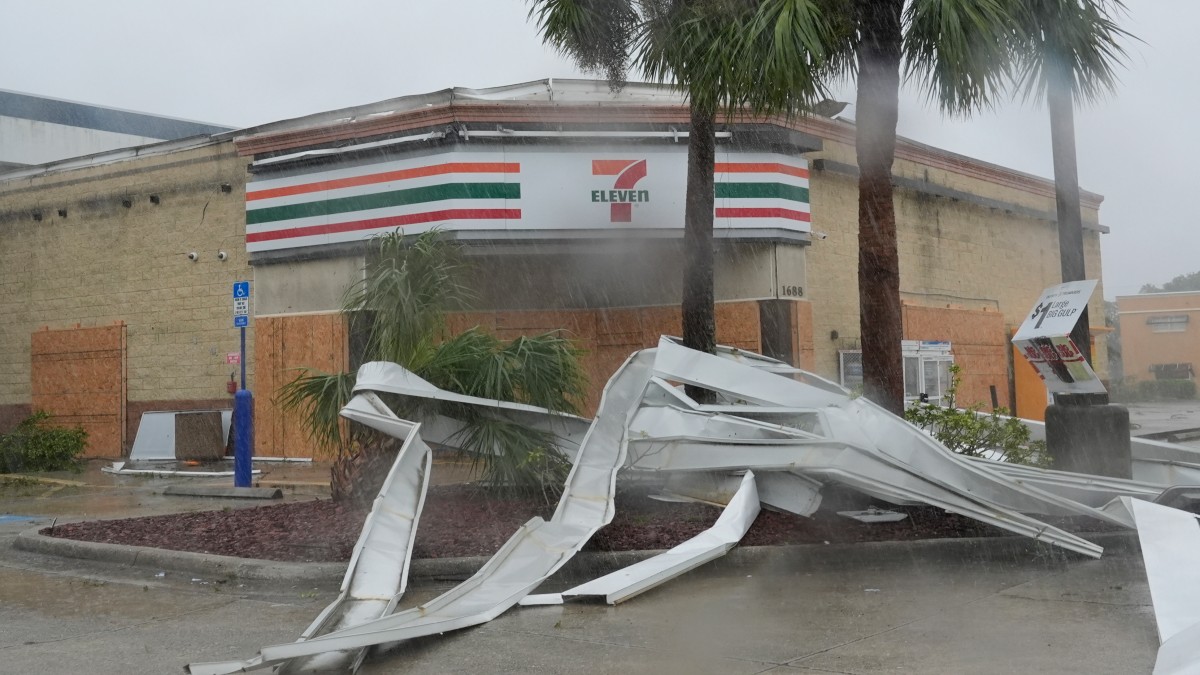Multiple powerful tornadoes ripped across Florida hours before Hurricane Milton made landfall on Wednesday.
In a state already battered by Hurricane Helene two weeks ago, as many as two million people were ordered to evacuate, and millions more live in the projected path of the storm.
Much of the southern US experienced the deadly force of Helene as it cut a swath of devastation through Florida and several other states.
Both storms are expected to cause billions of dollars in damage.
What is a tornado?
A tornado is a narrow, violently rotating column of air that extends from a thunderstorm to the ground.
It is hard to see a tornado unless it forms a condensation funnel made up of water droplets, dust and debris.
The Fujita scale is used to determine how powerful a tornado is. The highest on the scale – an F5 – is used to categorise tornadoes travelling at up to 318 metres per hour.
Tornadoes can cause incredible damage, with the power to throw away vehicles and sweep away strong buildings.
Tornadoes usually occur in Australia, Europe, Africa, Asia, and South America.
As per NSSL, New Zealand reports about 20 tornadoes each year.
How do tornadoes form?
The heat and humidity present in the atmosphere during such storms and changes in wind direction or speed with height, known as wind shear, contribute to tornadoes formation.
Impact Shorts
More ShortsWhen the moist and warm air meets the dry and cold air above, a thundercloud begins to build. This cloud quickly develops, bringing rain, thunder and lightning with it.
Winds blowing from different directions cause the air to rotate, after which a visible cone or funnel drops out of the cloud towards the ground.
Tornadoes can be hundreds of metres wide.
They can last anywhere from several seconds to more than an hour and can travel dozens of miles.
The Fujita scale is used to determine how powerful a tornado is. The highest on the scale of an F5 is used to categorise tornadoes travelling at up to 318 metres per hour.
These tornadoes can cause incredible damage, with the power to throw away vehicles and sweep away strong buildings.
Do hurricanes cause tornadoes?
Yes, they do.
“Hurricanes do produce tornadoes, but they’re usually weak. What we saw today was much closer to what we see in the Great Plains in the spring,” said Northern Illinois University meteorology professor Victor Gensini.
“It’s definitely out of the ordinary.”
Tornadoes spawned by hurricanes and tropical storms most often occur in the right-front quadrant of the storm, but sometimes they can also take place near the storm’s eyewall, according to the National Oceanic and Atmospheric Administration.
Tornadoes due to hurricanes are observed in more than 80 per cent of hurricanes that make landfall in the Gulf Coast, according to William Gallus at Iowa State University.
How has Milton spawned deadly tornadoes in Florida?
Hurricane Milton also spawned at least 19 tornadoes, Florida Governor Ron DeSantis said, causing damage in numerous counties and destroying around 125 homes, most of them mobile homes.
Roofs were torn off, vehicles were overturned and debris was sucked into the air as the black V-shaped columns moved through.
In Fort Myers on Florida’s southwest coast, resident Connor Ferrin surveyed the wreckage of his home, which had lost its roof and was full of debris and rainwater after a tornado suddenly hit.
“All this happened instantaneous like these windows blew out,” he said. “I grabbed the two dogs and ran under my bed and that was it. Probably one minute total.”
St. Lucie County’s Pearson estimated 100 homes were destroyed in the county where some 17 tornadoes touched down, NBC said.
Deaths were reported in St. Lucie County on Florida’s Atlantic Coast, but local authorities did not specify how many residents had been killed.
By Wednesday evening, more than 130 tornado warnings associated with Milton had been issued by National Weather Services offices in Florida.
Videos posted to Reddit and other social media sites showed large funnel clouds over neighbourhoods in Palm Beach County and elsewhere in the state.
“There’s an incredible amount of swirling going on,” Gensini said of the conditions that allowed for the twisters to grow. “Those tornadoes were just in a very favourable environment.”
Luke Culver, a meteorologist with the National Weather Service in Miami, said he wasn’t sure whether Milton had spawned a record number of tornadoes, but he pointed out that only 64 Florida tornado warnings were associated with Hurricane Ian, which hit the Tampa Bay area as a massive storm in 2022.
What’s the difference between a tornado and a hurricane?
Both hurricanes and tornadoes are marked by a ring of intense upward motion encircling a downward motion in the middle, as well as by incredibly strong horizontal winds swirling around it.
In the northern hemisphere, both typically spin anticlockwise, and in the southern hemisphere, clockwise. Interestingly, the direction in which the storms rotate in each hemisphere is determined by the rotation of the Earth.
The primary difference between a hurricane and a tornado is that the former has a horizontal scale that is roughly a thousand times bigger than the latter.
Tornadoes and hurricanes affect the atmosphere differently and originate under different conditions.
While tornadoes typically last only a few minutes and rarely travel more than 10 or 20 miles along the ground, hurricanes may travel thousands of miles and persist over several days or weeks.
With inputs from agencies


)

)
)
)
)
)
)
)
)



